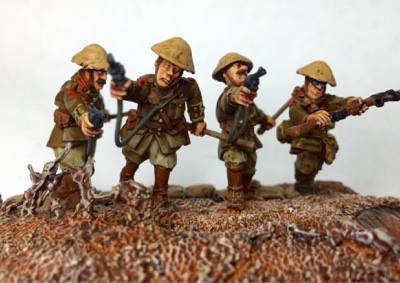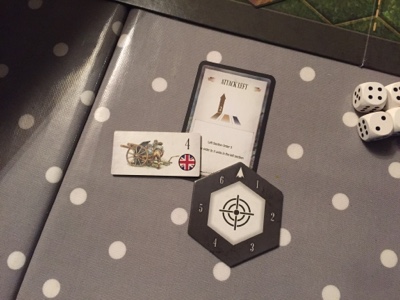Having finally finished painting all the figures from the basic game + the guns and Generals from the Kickstarter package it was time to start to learn the game mechanisms.
I thought I'd start with the first scenario at the back of the rule book. Laying out the way German trenches first, I experienced the frustration I've read about when trying to locate trench junction hexes. Because the hexes are printed on both sides, you've got to keep turning them over to find what you want. Careful storage will solve this one, keep all the junctions together.
Having laid out both front lines, I deployed the units as recommended in the scenario.
Next I dealt five command cards a piece and two combat cards. Each side started with six HQ tokens as well.
The British command cards presented them with three cards to order the left hand section of the board, one for the centre and one that allowed units to be ordered in the left and right sections.
I thought I'd get straight into it to see what the mechanism should do. I advanced out of the trench one hex and tried a ranged attack at maximum range. A single dice role, but I got a burst symbol - one hit!
Next move the Germans got their opportunity to pay me back. Two hits and a retreat one hex. Back where I started and two lives down. Well ranged combat is simple enough!
Next let's try ranged attacks by the reserve artillery. They need to be ordered to do so, just like the infantry units. Both sides had strength 4 artillery, meaning they roll four D6 to find out what they've hit.
Artillery template placed on target hex with the 6 facing their base edge. Four dice rolled.
The barrage landed in hexes 2, 4 & 5. The double four means one barrage landed on target. This was rolled first and gave me an HQ token. The others had no effect as no one was in the hexes.
The German barrage next move was equally ineffective.
Time to try the close combat mechanisms. An order four random units and add an extra dice to their combat phase command card allowed me to advance to contact in two places. The combat dice were rolled and the reductions for being in a trench were applied. Both combats resulted in the enemy units taking two hits -a good start.
The following turn, the Germans were unable to order a counter attack, so once it was my turn once more the British capitalised on the situation, caused two more hits on one unit -destroying it. The British unit could now follow up and occupy the hex and take a victory medal counter.
All in all quite easy to learn......difficult to master! I think you need to build up the pressure (artillery, mg and mortar fire) before you can launch a breakthrough attack. More practice definitely needed, but a good start. I think I'm going to like the Great War.


















